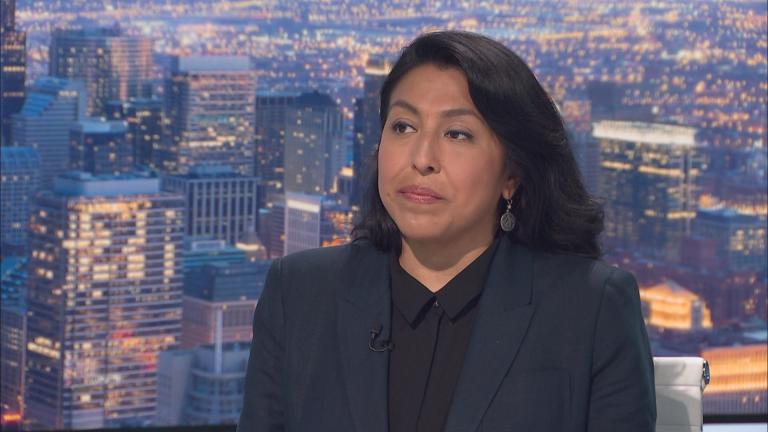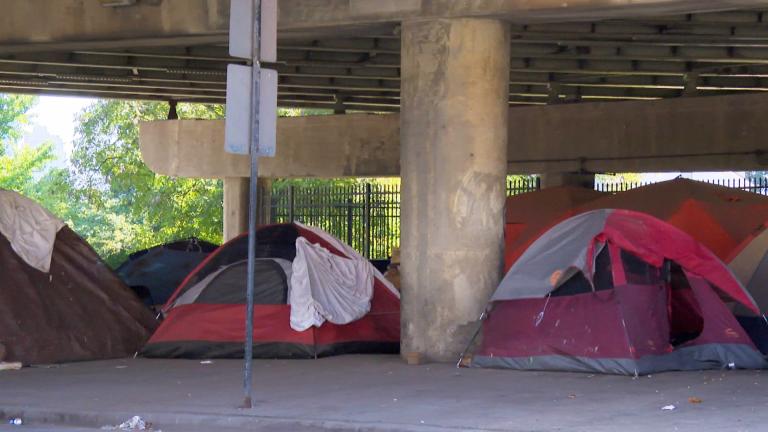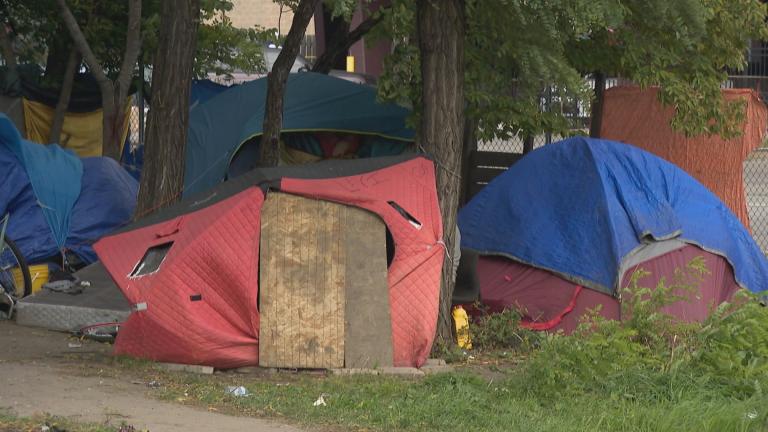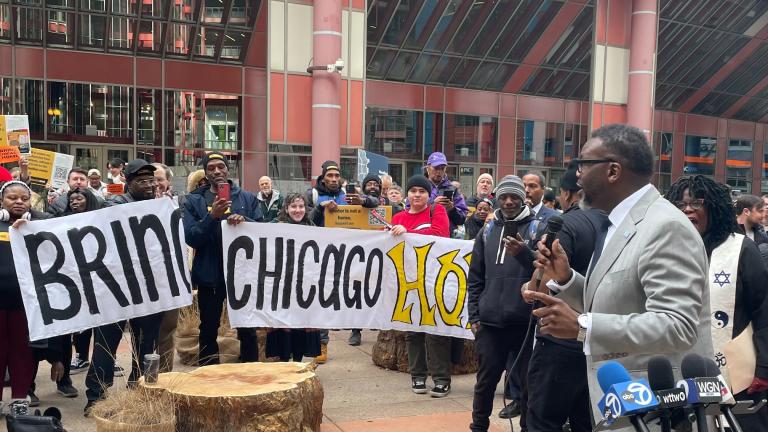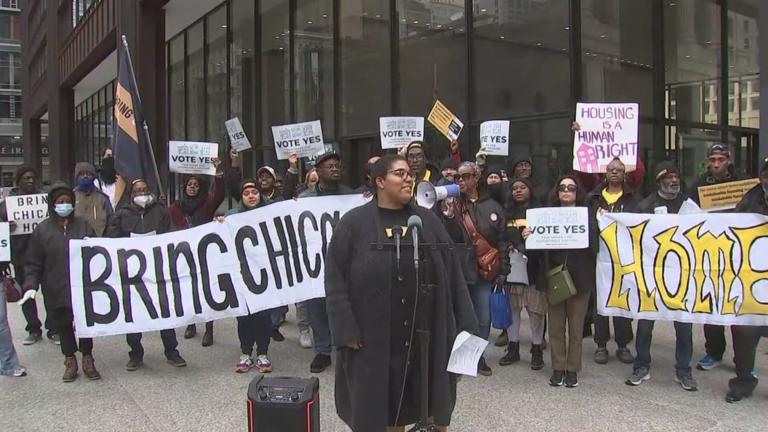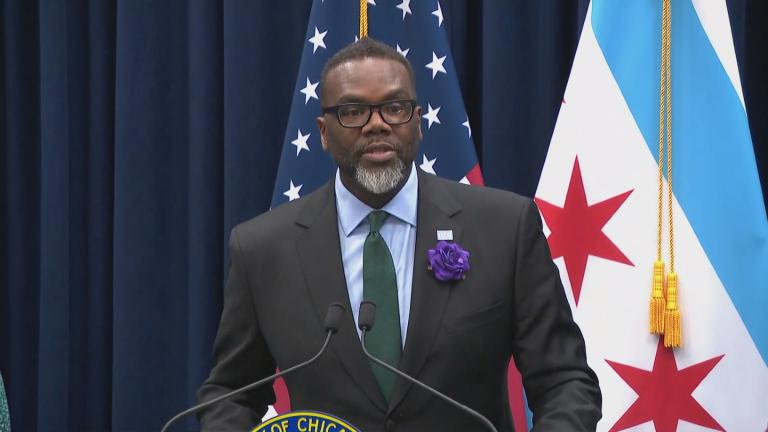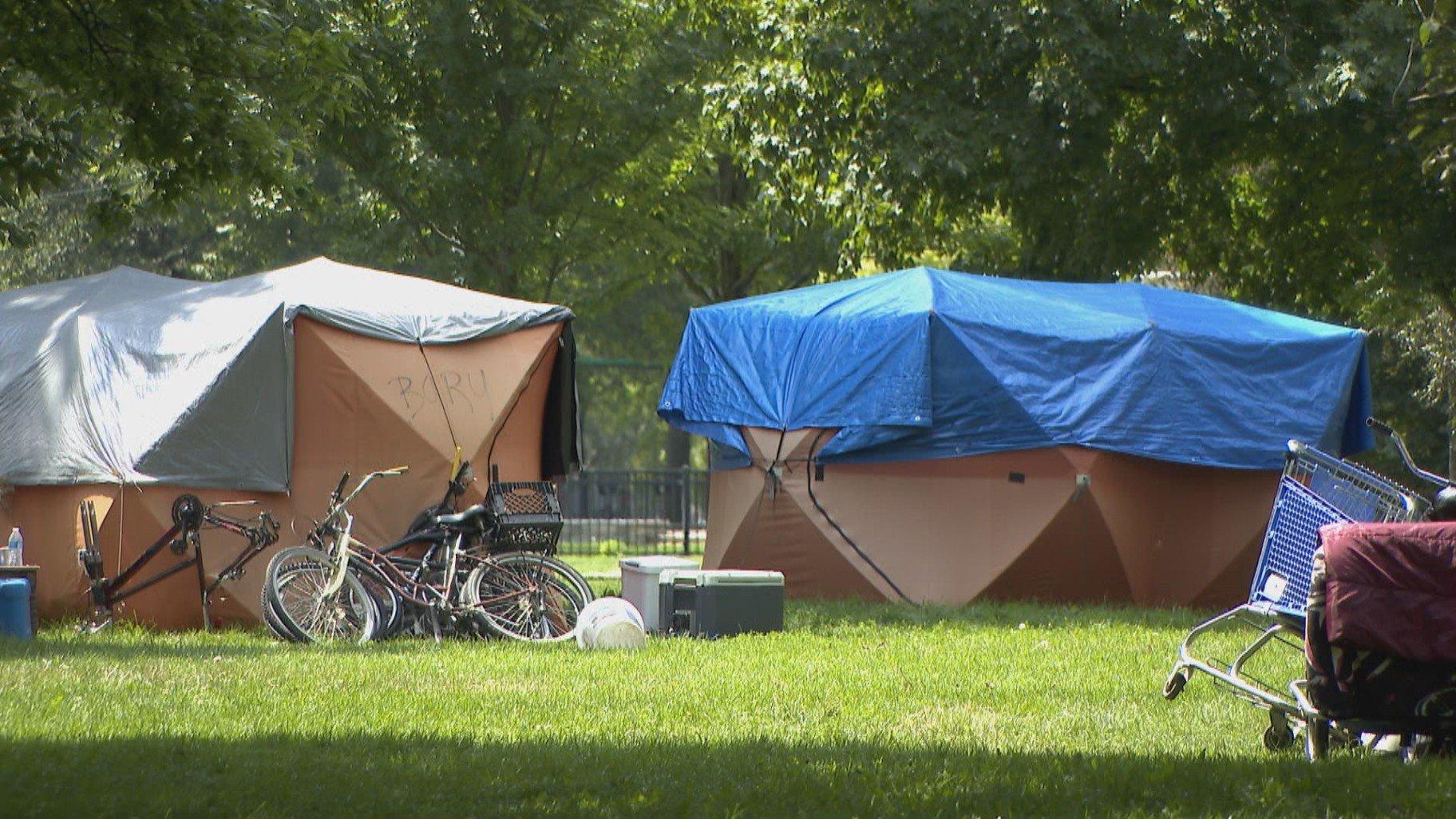 A homeless encampment in Humboldt Park. (WTTW News)
A homeless encampment in Humboldt Park. (WTTW News)
The number of Chicagoans living in city shelters or on city streets tripled between January 2023 and January 2024, according to the annual survey used by federal officials to track homelessness, city officials announced Friday.
More than 18,800 people in Chicago lacked a permanent place to sleep, according to the annual “point-in-time” count, which sends volunteers out to count the number of unsheltered people on the city’s streets on a single night and is used by U.S. Department of Housing and Urban Development officials to determine federal funding levels. The 2024 count took place on Jan. 25.
That is an increase of more than 200% in the past year, driven largely by the arrival of 35,000 migrants from the southern border, all of whom are in the country legally after requesting asylum. Children account for one-third of Chicago’s unhoused population, according to the survey.
“We aren’t rising to the occasion,” said Doug Schenkelberg, the executive director of the Chicago Coalition for the Homeless.
The results of the point-in-time survey are “disheartening but not surprising,” Schenkelberg said.
“It is clear that the problem is continuing to grow,” Schenkelberg said.
Maura McCauley, managing deputy commissioner for the Chicago Department of Family and Support Services, said city officials remain committed to making homelessness in Chicago rare, brief and non-reoccurring.
That has become more difficult as rents rise throughout Chicago and programs designed to prevent people from becoming unhoused during the COVID-19 pandemic expire, McCauley said.
Since the survey was conducted, an additional 8,000 men, women and children have made their way to Chicago from the southern border. Despite that, the number of migrants in city shelters has dropped by more than 50% since late January, as city officials began enforcing a 60-day limit on shelter stays and the pace of new arrivals to Chicago slowed significantly.
More than 1,600 Chicagoans were completely unsheltered at the time of the survey, according to the results. That represents an increase of 65% as compared with the results of the 2023 survey.
Nearly 87% of unhoused Chicagoans who are not living in city shelters are longtime residents of the city, according to the data.
Approximately 72% of longtime Chicagoans experiencing homelessness are Black, even though Black Chicagoans make up less than 29% of the city’s population, according to the 2020 census.
Black Chicagoans have long been more likely to be unhoused than White, Asian or Latino Chicagoans, and city officials are determined to reverse that trend, McCauley said.
The number of longtime Chicagoans who are unhoused grew by 25% between January 2023 and January 2024, according to the survey.
According to federal data, the number of unhoused people in Chicago was essentially steady between 2013 and 2023, with an average of more than 5,500 men, women and children without a permanent place to sleep on any given night.
That changed with the arrival of more than 43,000 migrants in Chicago, most on buses paid for by Texas Gov. Greg Abbott, a Republican, as part of an effort to damage President Joe Biden’s chances for reelection and divide Democratic voters.
The one-two punch of first the COVID-19 pandemic and then the migrant crisis shredded the city’s social safety net and made it impossible for most Chicagoans to ignore the growing number of unsheltered people on the city’s streets.
The crisis has also exacerbated tension between Chicago’s Black and Latino communities. While most of the new arrivals, as city officials refer to the migrants, are Latino, many longtime Chicagoans are Black and live in neighborhoods that have suffered from disinvestment for decades — with no end in sight.
Schenkelberg said the increase documented by the point-in-time count is especially troubling because the methodology it uses is woefully inadequate, since it does not consider people living “doubled-up” with friends or relatives temporarily to be homeless.
Instead, federal officials only consider people who do not have “a fixed, regular, and adequate nighttime residence” outside a shelter to be homeless.
In fact, nearly 10 times more people are actually homeless every day in Chicago than the official federal count would have you believe, according to a 2023 analysis of U.S. Census American Community Survey data collected in 2021 by the Chicago Coalition for the Homeless. An estimated 68,440 Chicagoans experienced homelessness in 2021, a 4% increase from data collected in 2020, according to the analysis based on the most recent data available for study.
Schenkelberg said it was particularly frustrating to see the increase in the number of unhoused Chicagoans in the wake of the defeat of the proposal known as Bring Chicago Home, which would have allowed the Chicago City Council to hike taxes on the sales of properties worth more than $1 million to generate $100 million annually to address the root causes of homelessness by building new permanent housing that offers wraparound services.
Without a dedicated source of revenue to combat homelessness, city officials will face significant financial limitations, especially as the city exhausts its share of federal COVID-19 relief funds, Schenkelberg said.
“The impact of that funding was meaningful,” Schenkelberg said. “The situation would be even worse without it.”
All of those funds must be spent by the end of 2026, a fact that is deeply concerning, Schenkelberg said.
City officials were determined to build sustainable infrastructure to address homelessness in Chicago based on the lessons learned during the pandemic, McCauley said.
To do that, city officials will rely on a plan approved by the City Council to borrow $1.25 billion during the next five years to fund a wide-ranging slate of projects designed to expand the supply of affordable homes and good-paying jobs.
City officials have been warning for more than a year that Abbott would send as many buses of migrants to Chicago as possible to cause chaos in the weeks leading up to the Democratic National Convention this August.
However, warnings of a new surge of migrants to Chicago, alongside the seasonal increase of people crossing the southern border to request asylum in advance of the convention, have yet to materialize.
A new policy implemented by Biden this week could curtail the number of migrants allowed to enter the country after requesting asylum and could reduce the number of people making their way to Chicago and New York, easing pressure on Johnson and New York City Mayor Eric Adams.
The number of migrants arriving in Chicago has risen 4.8% in the past month, according to city officials.
Fewer than 7,000 people were living in 17 city facilities as of Thursday, a 13% drop since May 6, according to city data.
Contact Heather Cherone: @HeatherCherone | (773) 569-1863 | [email protected]

